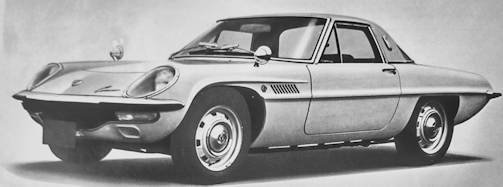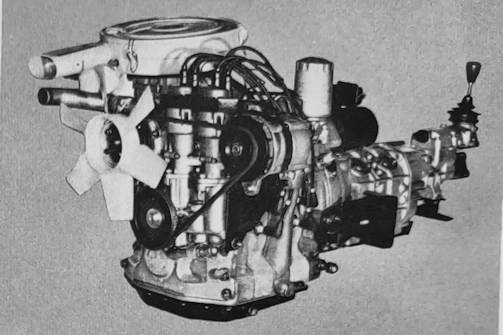Mazda Cosmo Sports First generation
 |
|
|
country of manufacture |
Japan |
|
Production |
1967 to 1972 |
|
design manager |
Kenichi Yamamoto |
|
designer |
Heiji Kobayashi |
|
body type |
2 door coupe |
|
engine position |
front |
|
Drive system |
rear wheel drive |
|
engine |
10A type 982cc 2 rotor |
|
Maximum output |
110PS/7,000rpm (L10A) |
|
Maximum torque |
13.3 kgf m/3,500 rpm (L10A) |
|
transmission |
4-speed MT (first term)/5-speed MT (late term) |
|
Wheelbase |
2,200/2,350mm (Early/Late) |
|
full length |
162.60 in, 4,130 mm |
|
Width |
62.80 in, 1,595 mm |
|
Height |
45.85 in, 1,165 mm |
|
vehicle weight |
2,117 1b, 960 kg |
|
Produced |
1176 |
The Mazda Cosmo sport 1st Generation was a small sports car from Japan built from 1967 to 1972.
History
In 1963 at the Japan Auto Show the Cosmo Sports Prototype was also displayed. The first time the Cosmo Sport prototype was made public was in October 1963.In August 1967 under the name of Mazda 110S, this production car with a two-disc Wankel engine was also the world's first car equipped with a two-disc more practical and mass-produced rotary engine. The world's first car with the single disc Wankel engine was released by the former NSU Wankel in 1964 Cosmo Sports began selling 343 units of the L10A model by 1967.
The Cosmo project was launched in December 1962 by Mazda. Mazda completed the first two-disc engine prototype in July 1963. The first mobile prototype of the Cosmo Sport was completed in August 1963. This was presented in October 1963 at the Tokyo Motor show, under the title "Project L402A".
The prototype engine L8A had a chamber volume of 2 × 398 cm³. The L8A still uses combined side and circumferential inlets. The L8A was further developed to the L10A and the chamber volume increased to 2 × 491 cm³. The circumferential inlets were eliminated and replaced with two additional side inlets in the front and the end of the engine. This improved the torque and driveability at low speeds. By October 1964, another prototype car was officially exhibited for the first time and again in 1966.
The L10A had an engine output of 110 hp (81 kW). The advancement L10B had the same chamber volume as the L10A, by changed control times one had increased the achievement of the engine on 128 HP (94 KW). Thus, the Cosmo Sport accelerated in 8.8 s to 100 km / h and reached 200 km / h.
In April 1966, Mazda produced 80 pilot series Cosmo Sport, of which delivered 60 pieces to dealers in Japan for field testing. From the first production version with the engine L10A (May 30, 1967 to July 1968) 343 pieces were produced.
Cosmo Sports’ early model L10A was a front-engine, rear-drive car equipped with a 10A rotary engine (491 cc x 2). With a high compression ratio of 9.4 and twin plugs, it produced 110 PS / 7,000 rpm and 13.3 kgf · m / 3,500 rpm. The car only weighed 940 kg. For the suspension, independent suspension with double wishbones and coil springs at the front and independent suspension at the rear were abandoned, but a de Dion axle was suspended with leaf springs to reduce un sprung weight.
The body, was a semi- monocoque system which was specially designed for mounting the rotary engine. The steering gear uses a quick rack and pinion format. The transmission was a 4-speed full synchro, and the brakes were Dunlop type discs on the front wheels and Alfin drums on the rear wheels. In addition, the brakes are tandem master cylinders with two independent front and rear systems, providing high safety in case one of them breaks down. The rotary engine was placed as low and rearward as possible, making full use of the concept of a front-midship that later became Mazda's identity.
The battery, which is a heavy item, was placed in the trunk in the early model, and in the late model it was housed in a case with a lid that was opened and closed with a knob provided behind the passenger seat. The aluminium instrument panel combined with the full - padded dashboard is unified in matt black, and the non-reflective glass gauges (from left: clock, fuel gauge, ammeter, speedometer, tachometer, oil temperature gauge, water temperature gauge). order) are arranged in an orderly fashion. The interior is fully trimmed with black vinyl leather, including the ceiling, and black and white houndstooth patterned wool is used only in the centre of the seat in consideration of breathability.

The interior design was handled by an interior team headed by Ryoichi Soma. Fitted with a three-spoke Nardi wood steering wheel that can be adjusted back and forth is standard. The floor covering is a bright red carpet, and the shift knob is in the position where the hand is naturally lowered, making it a short stroke that can be operated without moving the arm. Auto radio made by Clarion, semi- automatic antenna with a toggle switch that operates up and down, meter illumination adjustment, horn sound quality switching (for city use, high speed use), 2-speed wiper (Even if the switch is turned off during wiping, it returns to the stop position. glove box, trunk lamps were standard equipment.
The second production version with the L10B (July 13, 1968 to September 1972) was built 1176 times. Thus, a total of 1519 production vehicles (about 1599 included with pre-production vehicles) of the type Cosmo Sport were produced. The Cosmo Sport was only sold in Japan.

As early as July 1968, a minor change from L10A to L10B was carried out, expanding the radiator air intake, newly establishing a brake cooling port, expanding the wheelbase and tread, and increasing the transmission to 5 speeds, booster (Hydro master) to the front and rear brakes was installed. Radial tires were standardized (155HR15), and power was increased (110 PS / 13.3 kgf m to 128 PS / 14.2 kgf m) by improving intake efficiency due to port timing changes. As a result, the maximum speed increased from 185 km/h to 200 km/h, and the 0-400 m acceleration also decreased from 16.3 seconds to 15.8 seconds.
PERFORMANCE
- Engine capacity: 29.96 x 2 cu in, 491 x 2 cu cm
- Fuel consumption: 27 ml imp gal, 22.4 ml US gal
- Max speed: 124.3 mph, 200 kmlh
- Power-weight ratio: 16.5 lb/hp, 7.5 kg/hp
- Acceleration: standing 1/4 mile 15.8 sec
- Specific power: 130.5 hp/l
- Max speeds: 34.2 mph, 55 km/h in 1st gear; 55.9 mph, 90 km/h in 2nd gear; 83.9 mph, 135 km/h in 3rd gear; 115 mph, 185 km/h in 4th gear; 124.3 mph, 200 km/h in 5th gear
In addition, the four switches of the interior washer, wiper, dimmer, and turn signal are combined into one combination lever. 3-point seat belts and adjustable headrests were also equipped from the latter model. Parking (automatically turns off when the engine starts) and emergency lights were also installed.
The car was built 1519 times, excluding right-hand drive. It was a two-seater coupe; the body is in large parts and its engine made of aluminium. In 1968, it was built at a slightly lower total length with a longer wheelbase.
All generations have a coupe- type body (only the 3rd generation has a 4-door sedan), but its characteristics differ greatly depending on the generation. In addition, all but the third generation were sold with different names for each generation. Under the model’s name Cosmo until 1995 various successor models were produced.
Technical
-
Mazda Cosmo Sports 1st Gen Technical details and specifications (1967-1972)
ENGINE
location front
4 stroke, Wankel type; 2 co-axial 3-10be rotors
engine capacity:29.96 x 2 cu in, 491 x 2 cu cm
compression ratio: 9.4
engine block: light alloy
rotors: cast iron
crank-shaft bearings: 3
lubrication: gear pump, full flow filter, oil-water heat exchanger
carburation: I Hitachi-Stromberg 4-barrel carburettor
fuel feed: electric pump
cooling system: engine block by water, rotors by oil
(Optional) air conditioning system.TRANSMISSION
driving wheels: rear
clutch: single dry plate (diaphragm);
gearbox: mechanical; gears: 5+ reverse
gearbox ratios: 1st 3.379, 2nd 2.077, 3rd 1.390, 4th 1, 5th 0.841, rev 3.389
gear lever location: central
final drive: hypoid bevel
axle ratio: 4.111.CHASSIS
type integral
front suspension: independent, wishbones, coil springs,anti-roll bar, telescopic dampers
rear suspension: de Dion rigid axle, semi-elliptic leafsprings, telescopic dampers.STEERING
rack-and-pinion
turns of steering wheel lock to lock: 2.98.
turning circle (between walls): 34.1 ft. 10.4 mBRAKES
front disc, rear drum lining area: front 20.71 sq in, 133.60 sq cmELECTRICAL EQUIPMENT
voltage: 12 V
battery: 45 Ah
generator type: alternator, 360 W
ignition distributor: MitsubishiDIMENSIONS AND WEIGHT
wheel base: 92.52 in, 2,350 mm
front track: 61 in, 1,260 mm
rear track: 49.21 in, 1,250 mm
overall length: 162.60 in, 4,130 mm
overall width: 62.80 in, 1,595 mm
overall height: 45.85 in, 1,165 mm
ground clearance: 4.92 in, 125 mm
dry weight: 2,117 1b, 960 kg
distribution of weight: 50.5% front axle, 49.5% rear axle© Motor car History
Service
-
Mazda Cosmo Sports 1st Gen Maintenance and Service Guide (1967-1972)
Fuel: 85-90 oct petrol
Engine oil change: 6.69 imp pt, 8.03 US pt, 3.8 1, SAE 10W-30, change every 4,000 miles, 6,400 km
gearbox oil: 3.50 imp pt. 4.23 US pt. 2 1, SAE 90, change every 29,800 miles, 48,000 km
Final drive oil: 1.60 imp pt. 1.99 US pt. 0.9 1, SAE 90, change every 29,800 miles, 48,000 km
Cooling system capacity: 8.45 imp pt, 10.15 US pt
Greasing: every 29,800 miles, 48,000 km, 13 points
Normal tyre pressure: front 20 psi, 1.4 atm, rear 20 psi, 1.8 atm.
Width of rims: 4.5"
Tyres: 155 x 15
Fuel tank capacity: 12.5 imp gal, 15 US gal
Carrying capacity: 551 1b, 250 kg© Motor car History
